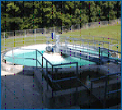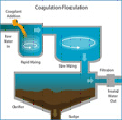Typically, the primary objective of warm lime softening is to lower levels of hardness and silica. This takes places through the chemical principal of precipitation. Increased temperature decreases the chemical solubilities of constituents that make up hardness such as calcium and magnesium and also for silica and therefore increases the efficiency of the lime softening system
This type of softening typically operates between temperatures of 50 – 65 C. This is the more preferred and efficient type of softening as opposed to standard (cold) lime softening.
Temperature control for this system is very important for the process and needs to be controlled in order to prevent precipitation of lime scale.
This warm lime softening can be used for cooling tower blowdowns, municipal drinking water applications, demineralization systems, heat recovery systems and other systems.
A typical lime system can consist of the following equipment:
Fast Mixing chambers where influent is injected with lime
Chemical addition for enhancing settling (typically coagulant/flocculants)
Main Settling Clarifier where settling occurs
Sludge dewatering and or recycling system
Hot Lime Softening:
Hot lime softening essentially works the same way as described above at temperatures of 100 – 120 C. Typically, the raw water is stripped of CO2 and the process can reduce silica down to <2 ppm and hardness to less than 8 ppm.



